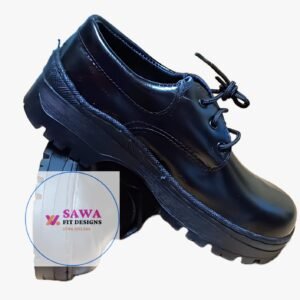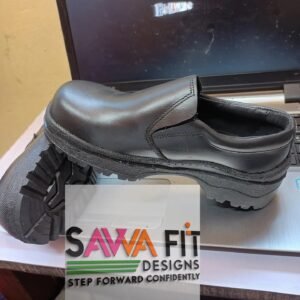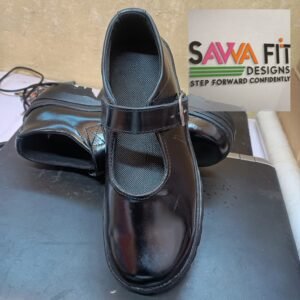Find the perfect shoes for kids with our comprehensive guide. Learn how to choose supportive, comfortable, and durable footwear for healthy foot development at every age.
-
Back to School Shoes -Genuine Pure Leather
Original price was: KSh1,300.KSh1,000Current price is: KSh1,000.Select options This product has multiple variants. The options may be chosen on the product pageClear3234242526272829303133 -
Boys Black School Shoes
Original price was: KSh1,500.KSh1,200Current price is: KSh1,200.Select options This product has multiple variants. The options may be chosen on the product pageClear363835373940 -
Slip-On School Shoes Boys
Original price was: KSh2,500.KSh2,000Current price is: KSh2,000.Select options This product has multiple variants. The options may be chosen on the product pageClear323436382728293031333537 -
Girls School Shoes (Buckle)
Original price was: KSh1,800.KSh1,400Current price is: KSh1,400.Select options This product has multiple variants. The options may be chosen on the product pageClear3837
Children’s feet are constantly growing and developing, making the right pair of shoes incredibly important. More than just a fashion statement, shoes for kids play a big role in their comfort, posture, and overall foot health. Choosing correctly helps prevent issues down the road and supports their active lives.
Shoes for Kids: Why Proper Shoes Matter for Growing Feet
A child’s foot is not simply a miniature adult foot. Their bones are softer and still forming, making them more susceptible to problems from ill-fitting footwear. The arches and other foot structures develop over time, needing proper support to form correctly. Good shoes help maintain the foot’s natural shape and alignment, which is essential for developing balance, posture, and body mechanics. They also reduce stress on growing bones and joints, supporting better movement and lowering injury risk.
Ill-fitting shoes can cause immediate discomfort and long-term problems. These issues include:
- Foot Deformities: Shoes that are too tight or too loose can lead to deformities such as bunions, hammertoes, and flat feet.
- Blisters and Sores: Poorly fitting shoes create friction and pressure points, causing blisters, sores, and calluses.
- Pain and Discomfort: These conditions often cause pain and discomfort, affecting a child’s ability to walk or run.
- Poor Posture and Balance: Inadequate support can negatively affect a child’s posture and balance, leading to compensatory movements and potential issues in the knees, hips, and back.
- Reduced Mobility: When children experience pain or discomfort from their shoes, they might become less inclined to participate in physical activities, affecting their overall health and development.
- Long-Term Issues: Chronic foot problems developed in childhood can persist into adulthood, causing ongoing discomfort and potentially requiring medical intervention.
Key Features of Good Shoes for Kids
When you pick out shoes for your child, look for specific features that promote healthy foot development and comfort.
Flexibility
A good children’s shoe should be flexible, especially in the sole. The sole should bend easily at the ball of the foot, allowing for natural movement and proper arch development. A stiff sole restricts movement and can hinder natural gait.
Support
While flexibility is key, a shoe still needs to offer adequate support. Look for:
- Firm Heel Counter: This is the back part of the shoe that cups the heel. A firm heel counter helps stabilize the foot and prevent it from sliding around inside the shoe.
- Arch Support: While many young children have naturally flat feet, proper arch support in shoes helps guide the foot’s development as they grow.
- Secure Fastenings: Velcro straps, laces, or buckles help secure the foot in the shoe, preventing excessive movement and providing a stable fit.
Breathable Materials
Children’s feet sweat a lot, so choose shoes made from breathable materials like natural leather, mesh, or canvas. These materials allow air circulation, keeping feet dry and comfortable, and reducing the risk of blisters and fungal infections. Avoid synthetic materials that trap moisture.
Lightweight Design
Heavy shoes can be tiresome for little legs. Opt for lightweight materials that make it easier for your child to walk, run, and play without feeling weighed down.
Wide Toe Box
The front of the shoe, or toe box, should be wide and rounded. This gives your child’s toes plenty of room to wiggle and spread naturally, preventing cramping and allowing for proper toe function.
Different Stages, Different Shoes
The type of shoes your child needs changes as they grow and their activity levels shift.
Pre-Walking and First Walkers (Babies and Toddlers)
For babies learning to crawl and stand, pre-walking shoes are about protection. They should be soft, lightweight, and very flexible, almost like a second skin. Once your child starts taking their first steps, focus on “first walker” shoes.
- Soft, Flexible Soles: Allows for natural foot movement and sensory feedback.
- Slip-Resistant Outsoles: Provides traction for tentative steps.
- Easy-On Designs: Wide openings and adjustable closures make putting them on simple.
- Seamless Construction: Reduces irritation on delicate skin.
- Memory Foam: Adds comfort and cushioning.
Toddlers and Preschoolers (18 Months – 5 Years)
At this stage, children are active and exploring. Their shoes need to withstand more wear and tear while still providing support.
- Durable Construction: Look for sturdy materials and reinforced toe areas.
- Flexible Sole with Good Grip: Supports running, jumping, and various activities.
- Easy Fastenings: Velcro remains popular for independence.
- Breathable Uppers: To manage increased sweating from activity.
School-Aged Children (5+ Years)
As children enter school, their footwear needs become more diverse, ranging from athletic shoes for sports to casual and sometimes formal options.
Athletic Shoes
For sports and active play, specialized athletic shoes provide necessary support and cushioning.
- Supportive Midsole: Provides shock absorption for running and jumping.
- Durable Rubber Outsoles: Offers good traction and resists wear.
- Reinforced Uppers: Prevents the foot from slipping inside the shoe during activity.
- Sport-Specific Features: Cleats for soccer, extra cushioning for running, etc.
Casual Shoes
These are everyday shoes for school and general play.
- Comfort and Durability: A blend of both is essential.
- Cushioned Insoles: For all-day comfort.
- Flexible Soles: To allow natural movement.
- Easy Closures: Velcro or laces depending on age and preference.
Formal Shoes
For special occasions, formal shoes are sometimes necessary.
- Comfort is Still Key: Even formal shoes should not pinch or rub.
- Proper Fit: Ensure they are not too tight or too loose, as they might be worn for extended periods.
- Material: Leather is common for a polished look.
- Style: Oxfords, Derby shoes, loafers, or Mary Janes are common choices.
How to Measure Your Child’s Shoe Size -Shoes for Kids
Accurate sizing is perhaps the most important factor. Children’s feet grow quickly, and they often don’t complain about ill-fitting shoes because their feet are still soft.
- Measure Regularly: Measure your child’s feet every 3-4 months, especially for younger children.
- Measure Both Feet: One foot might be slightly larger than the other. Always fit to the larger foot.
- Measure at the End of the Day: Feet tend to swell slightly throughout the day, so measuring in the evening gives the most accurate size.
- Stand Up: Have your child stand with their weight evenly distributed.
- Allow for Growth: You should have about a thumb’s width (around 1-1.5 cm) of space between the longest toe and the end of the shoe. This allows for growth and toe movement.
- Check the Width: The shoe should be snug but not tight across the widest part of the foot. Your child’s toes should not be squeezed.
- Heel Fit: The heel should fit snugly without slipping when your child walks.
If possible, visit a store with trained staff who can measure your child’s feet using a Brannock Device. This helps ensure a precise fit.
When to Replace Shoes for Kids
Children typically outgrow shoes long before they wear them out. Look for these signs it’s time for new shoes for kids:
- Toes Touching the End: If your child’s longest toe is at the very end of the shoe, they need a bigger size.
- Red Marks or Blisters: These indicate the shoes are too tight or rubbing.
- Difficulty Putting On/Taking Off: Shoes that are suddenly hard to get on might be too small.
- Changes in Gait: If your child starts walking differently or complaining of foot pain, their shoes might be the culprit.
- Worn Soles: While not as common as outgrowing, excessively worn soles (especially unevenly) can affect support and stability.
Choosing the right shoes for kids requires careful attention to detail, but the effort pays off in comfort, health, and happy, active children. Prioritizing flexibility, support, breathable materials, and proper fit helps ensure their feet develop well and stay healthy for years to come.
-
Back to School Shoes -Genuine Pure Leather
Original price was: KSh1,300.KSh1,000Current price is: KSh1,000.Select options This product has multiple variants. The options may be chosen on the product pageClear3234242526272829303133 -
Boys Black School Shoes
Original price was: KSh1,500.KSh1,200Current price is: KSh1,200.Select options This product has multiple variants. The options may be chosen on the product pageClear363835373940 -
Slip-On School Shoes Boys
Original price was: KSh2,500.KSh2,000Current price is: KSh2,000.Select options This product has multiple variants. The options may be chosen on the product pageClear323436382728293031333537 -
Girls School Shoes (Buckle)
Original price was: KSh1,800.KSh1,400Current price is: KSh1,400.Select options This product has multiple variants. The options may be chosen on the product pageClear3837



